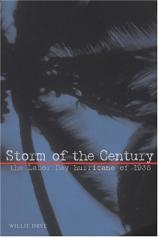Storm of the Century
Review
Storm of the Century
We may be witnessing the revival of a venerable literary genre
these days --- the book whose central figure is not a human being,
but a storm. Call them Big Blow Books. The most successful recent
example, of course, is Sebastian Junger's bestseller THE PERFECT
STORM.
Now comes journalist Willie Drye chronicling a killer hurricane
that struck the Florida Keys on Labor Day in 1935, leveling whole
villages and killing more than 400 people, most of them
impoverished workers imported from elsewhere to work on a federal
bridge-building project. Rather than concentrating, as Junger did,
on one small group of men aboard a single vessel, Drye roams up and
down the 160-mile expanse of islets, bays, straits, and narrows
between Miami and Key West. His cast of characters is large, his
perspective wide --- almost too wide, in fact, for the success of
his purpose.
Those federal workers at center stage in Drye's book form a kind of
doomed chorus of poor, hard-drinking, psychologically damaged World
War I veterans, many of them veterans also of the failed 1932 bonus
march on Washington --- the march broken up by federal troops under
the command of Douglas MacArthur. They are bitter men, scarred by
war, poorly housed and fed, former war heroes now regarded mainly
as troublesome nuisances by their government. It is an interesting
idea, but Drye has handled it rather clumsily. His book is full of
padding about the Depression and the national political
implications of what happened on that holiday weekend. Interesting
background to be sure, but far too detailed and not especially well
written. The reader becomes impatient for the "storm of the
century" to arrive and do its work.
There are heroes and villains aplenty. An emergency evacuation plan
existed for getting those workers off the totally exposed Keys in
the event of a hurricane, but its implementation fell victim to
misunderstandings, misinterpretations, faulty communications, human
personality quirks, and accidents of nature. The evacuation train
was blown off the tracks before it could get anybody out. The US
Weather Bureau, whose resources in those days were primitive,
issued warnings, but they were either ignored or misinterpreted.
Some of them, too, were simply inaccurate.
If there is a hero in this debacle it is one Ed Sheeran, an
official with the Florida Emergency Relief Administration and a
veteran of several previous hurricanes in the Keys dating back to
1906. He tried manfully to make colleagues and superiors aware of
what was happening and to move them to action. There are several
villains also, notably two of Sheeran's coworkers named Ray Sheldon
and Fred Ghent who simply failed to do their plain duty, at least
in author Drye's view.
An observer of the debacle from the relatively safe haven of his
Key West home was Ernest Hemingway, and Drye keeps the reader
informed of the great author's every move as the storm hits. An
interesting sidelight, but not really essential to Drye's
tale.
The final section of Drye's book is taken up with a pedestrian
account of the inevitable post-storm political blame game played
out among Republicans who wanted to crucify FDR in that
Presidential election year and Democrats who wanted to shield him
at all costs. Other players include the press, the weather bureau,
and various other stakeholders. In view of the huge landslide
electoral victory rolled up by FDR a little over a year after the
hurricane, the publisher's claim that the storm nearly cost him the
election seems preposterous. Not even Drye goes that far.
Among the several investigations of what went wrong, Drye is
devastating in his account of the quickie probe (completed in 48
hours) designed to exonerate the government and dismiss the whole
affair as an "act of God." His investigative hero is one David
Kennamer of the Veterans Administration who took his time, did a
thorough job and distributed blame with an even hand.
Drye's writing style is variable. Mainly he works in a series of
quick snapshots, moving abruptly from place to place along the Keys
and observing his large cast of human characters almost from minute
to minute. He can be annoyingly repetitive, and while there are
deft phrases scattered throughout, the cliche count is also high
(lots of things are "ill-fated"). The advance copy provided for
review of this book contained no map of the Keys; one assumes that
there will be one in the finished book --- it is absolutely
essential to understanding the course of events. Another serious
omission is the book's total lack of source notes. Drye's text is
full of direct quotations spoken under great stress 67 years ago.
Where did he get them? His publisher speaks vaguely of five years
of research, but no specifics are provided --- at least not in the
review copy.
This is a good book about a catastrophe that had many
ramifications, but it could have been a good deal better if more
attention had been given to organization, editing, and the placing
of emphasis where it belonged --- on the storm itself.
Reviewed by Robert Finn (Robertfinn@aol.com) on January 23, 2011
Storm of the Century
- Publication Date: August 1, 2002
- Genres: Nonfiction
- Hardcover: 320 pages
- Publisher: National Geographic
- ISBN-10: 0792280105
- ISBN-13: 9780792280101



